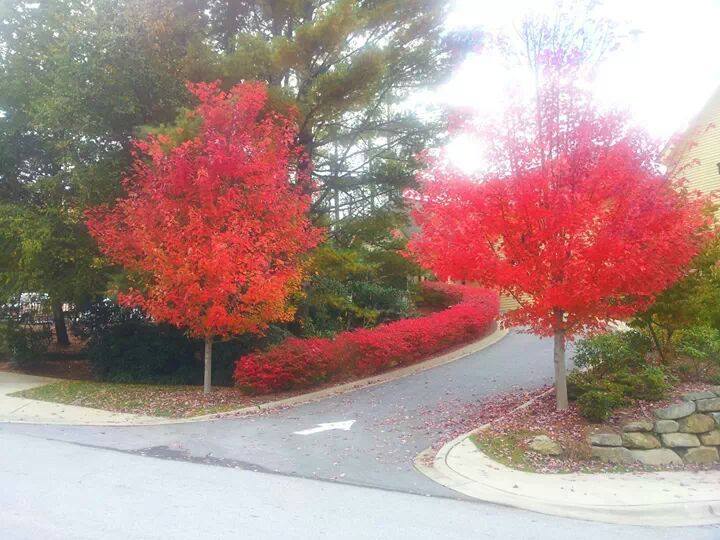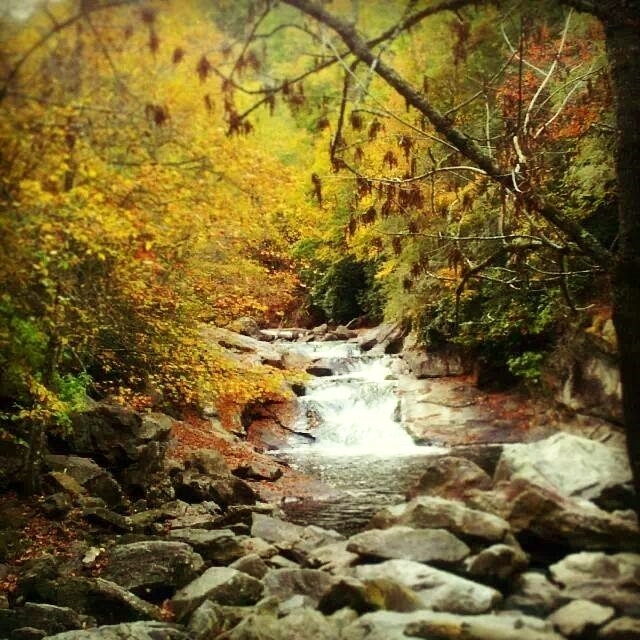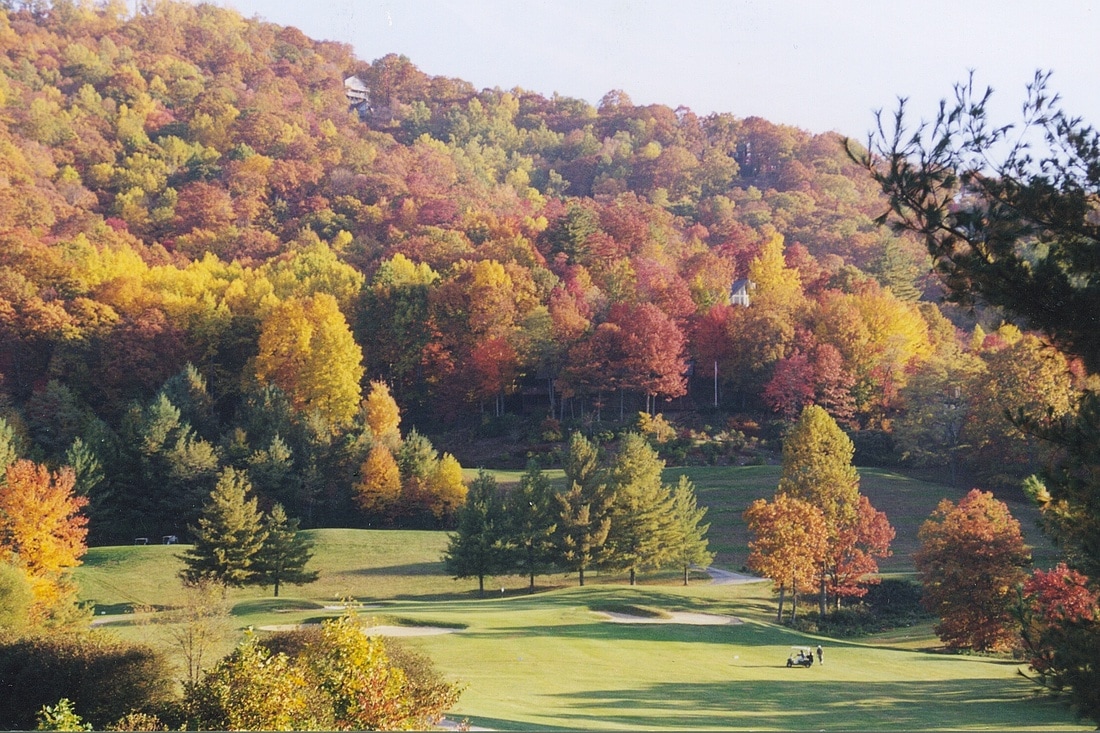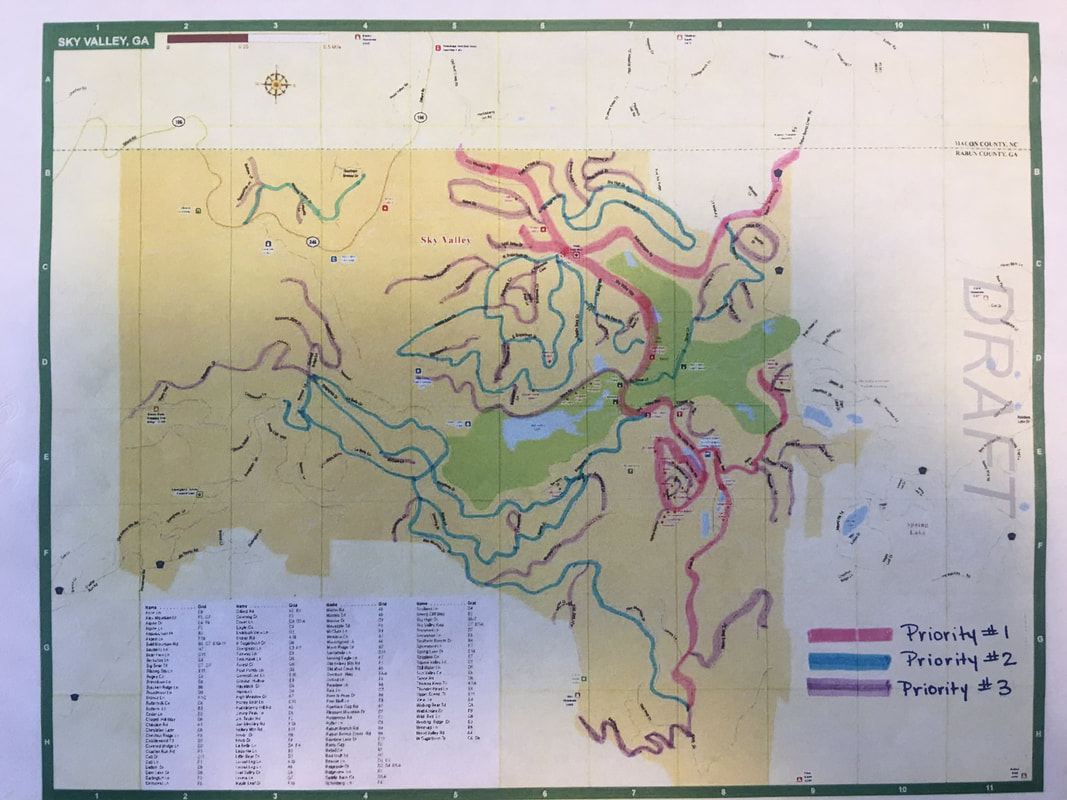Right-of-Way Mowing & LandscapeProviding for Rights of Way
The public works department provides mowing and related vegetation maintenance services along approximately 28 miles of Sky Valley streets and roadsides. During the summer, more effort goes toward mowing; in winter, more effort goes toward brush and tree side trimming. Mowing serves to maintain a safe zone adjacent to the road pavement, improves drainage of storm water from the road surface, and creates an attractive vista along road corridors. Tree limbs and shrubbery are trimmed to maintain clear sight lines for travel, traffic signs and safe vision distances at intersections. Generally, streets are serviced every two to three weeks. Other associated services include storm damage clean-up, culvert clearance, ditch cleaning, pruning, street tree planting and maintenance, pavement patching, street sweeping, leaf pick-up, snow removal, and other support services for the Public Works Department. Snow and Ice Control PlanThe Sky Valley Snow and Ice Control Plan is designed to make efficient use of staff, materials and equipment during winter storm events. Through proper management, our efforts will translate into cost savings for the public and a healthier/safer city in which to live, work and drive.
The following Snow and Ice Control Plan is designed to give an overall summary of how our snow operations are implemented. The Department of Public Works reserves the right to change or modify depending on weather conditions and resources available. PROGRAM GOALS Snowplowing shall proceed as rapidly as possible in accordance with the following priorities: Snow and ice control operations will be conducted only when weather conditions do not grossly endanger the safety of City employees and equipment. Factors that may delay snow and ice control operations include: severe cold, significant winds, restricted visibility, and equipment limitations. The goal of Sky Valley is to provide fiscally responsible service during snow and ice events that support the safety and mobility of our transportation system by removing or displacing snow and ice from designated priority streets as safely and expeditiously as possible. One only has to shovel a driveway a few times to know that snow has different weights and compaction properties. A rule of thumb is that a 10-inch accumulation of dry, fluffy snow is easier and cheaper to take care of than 5 inches of heavy, wet snow. Additional problems with wet snow include: very slippery conditions, salt usage increases, equipment fatigue, and newly fallen snow freezes. There is nothing worse for poor snow removal results than heavy, wet snow followed by a hard freeze. TREATMENT METHODS Treatment methods include: • Salt brine • Salt • Anti-skid materials • Plowing All of these methods are utilized, sometimes in different combinations, depending on the type of road and current weather conditions. Salt is used to melt the snow or ice. Brine is applied to roadways before snow begins to fall to help prevent the bonding of snow and ice to pavements. Anti-skid materials help provide traction and can be sand or fine stone, sometimes referred to as chat. Plowing is utilized when snow becomes too deep for salt granules to effectively penetrate. Plowing begins when snowfall is between 1 – 2 inches. The police department is responsible for notifying the public works director if it is after normal business hours when there is an inch of snow accumulation on the roadway. If there is less accumulation than we can plow, salt and/or anti-ski materials will be used to provide traction and assist in melting the snow or ice. STATEMENT OF OBJECTIVES Anti-icing measures take place before snow falls and ice forms on the roadway. They aim to prevent the bond of frozen precipitation to the road surface. In some circumstances, anti-icing can dramatically cut the cost of maintaining a safe road surface over conventional deicing. Anti-icing chemicals are applied in liquid form (salt brine) to road surfaces just before a snow or ice storm. Liquid sodium chloride (NaCl) is the most effective choice for anti-icing above 15° F. There are many factors that go into determining if anti-icing will be effective. Some of the factors are air temperature, wind speed, precipitation type and intensity, current pavement conditions, and location. Sky Valley uses these factors in an advanced weather forecasting system, as well as the experience of our maintenance crews, to determine when and where to anti-ice. If conditions are favorable for the use of anti-icing measures, salt brine will be applied to all streets. When that is not possible, anti-icing measures will be focused on steep hills, switchbacks and other known trouble areas. During a snow event, public works' primary goal is to have Priority #1 Streets plowed open at all times. This goal is contingent upon the time the snow event starts and the magnitude and duration of the snow event. The following priorities outline the established level of snow removal to be expected for streets in that priority level. • Priority #1 Streets: All main arterials considered to be the minimum network, which must be kept open to provide a transportation system connecting the fire station, police station and other essential operational areas necessary for snow and ice removal. Priority #1 Streets include Bald Mountain Road, Sky Valley Way, Knob Drive to the Public Works Barn, Lost Valley to the Public Works Materials Yard. • Priority #2 Streets: All other collector roads completing the network covering moderate traffic volume streets and selected “hot spots” such as intersections, hills and switchbacks. Our goal is to have all remaining Priority #2 Streets plowed within 48 hours of the last snowfall.
It is illegal for private persons to place, dump or push snow into city streets or rights-of-way from adjacent properties. STREET PLOWING AND TREATMENT OBJECTIVES Each individual snow storm presents unique conditions and challenges that warrant different approaches to snow and ice control. Factors such as wind, moisture content of the snow, pavement temperature, ice build-up on road surfaces and projected snow accumulations all influence snow fighting strategies. Standard operating procedures involve plowing and spreading de-icing materials from the center to the right side of the road. The first crew dispatched for a storm will apply de- icing materials as needed to the road surface in an effort to prevent ice from bonding to the pavement. Plowing will begin when sufficient snow accumulations occur on the road surface. Plowing generally occurs when snow accumulation reaches 1 -2 inches. Subsequent crews will adjust techniques in order to meet conditions. De-icing adjustments are made in the field based on current and forecasted conditions. Field adjustments may include applying de-icing materials to the entire road surface or limiting them to icy spots, intersections, stop signs, hills and bridges. Techniques to be deployed will be based on storm conditions and duration to achieve optimal results and ensure the safety of motorists. In order to provide service to as much of the community in as timely a manner as possible, service will not include removal of the plowed windrows from driveways, sidewalks, mail boxes or along vehicles parked on the street. UNLAWFUL ACTS During an emergency it is unlawful to park or leave standing any vehicles on any street. Exceptions – This section shall not apply to persons in charge of wreckers or authorized emergency vehicles while servicing mechanical, fire, police or medical emergencies. DRIVEWAYS Responsibility of driveways shall rest with individual property owners. This includes the clearing of additional snow that may accumulate each time the City plows have gone by. RESOURCES Public Works consists of four Maintenance Workers. All employees are under the direction of the Public Works Director. There will be two workers in each plow truck at all times. Vehicles and equipment available for snow and ice control:
SNOW EMERGENCY The City Manager has the authority to declare a snow emergency when snow conditions are such that normal snow operations are not able to keep the streets clear. Snow emergencies enable the City Manager to call in additional outside resources and authorize overtime for all essential personnel over and above what may be allocated in the budget. As in normal snow removal operations, the Priority #1 Streets are the first plowed during snow emergencies. These emergency routes are designed to keep essential services functioning after a major snowfall or heavy drifting that could otherwise paralyze our city. Snow crews will work in conjunction with fire, police and ambulance personnel to ensure the life safety of the community. Other main streets are plowed immediately after emergency snow routes are completed. Vehicles parked on a snow route during emergency conditions may be towed at the owner’s expense. In addition, plows may continue to work the area around parked vehicles, blocking them with piles of snow. STUCK VEHICLES City staff is not permitted to use city vehicles or equipment to push, pull, drag or otherwise remove any private vehicles that are stuck or inoperable. Staff should call the Police Department to contact a tow for stuck residents. HOW YOU CAN HELP Exercise extreme care when driving in inclement weather. Driving on snow-packed and icy roads requires your full attention and driving skills. A few basic guidelines to remember during winter driving are: • During a snowstorm, you can help City crews by not parking in and along City streets. We cannot plow if you are blocking a road. You may also get snow-banked in if you park on the edge of the road. • Equip your vehicle with snow tires or chains to improve traction. Remember to brake slowly. • During times of poor road conditions, allow extra room between yourself and the vehicle ahead of you. • During times of reduced visibility, watch for other vehicles and pedestrians. • Be patient. Drive at reduced speed and allow more travel time to reach your destination. • Give snow removal personnel and equipment time and room to do their job. QUESTIONS AND ANSWERS It seems like we’re always plowed last. Why can’t we be first sometimes? We follow the snow removal priority plan and often start and stop at the same location. This is based on a number of factors such as stockpile location, conditions and the number of one-way and dead-end streets in the City. When is it OK to park on my street again after it has been plowed? You can park in any permitted parking area as soon as the snow has been plowed to its full operation width. Be careful, however; it may take more than one pass of the plows to complete the job. I’m very concerned about our environment. Why don’t you do more plowing and eliminate the use of chat or salt? Plowing and de-icing serve different purposes. Both need to be done to ensure the safety of the traveling public. Who can I call if I’ve got a complaint or request? For the quickest response on your snow plowing or de-icing questions, call 706-746-2204. After normal business hours, call the Police Department at 706-746-5584 and they will contact our on-call personnel. Can’t the City remove the snow they put in my driveway? Given the large number of driveways in the City, it is too time consuming to perform this service. Our primary duty is to keep the main roadways open. Our crews try to keep blocked driveways to a minimum and divert plowed snow away from driveways when possible. I’d like to make a suggestion on snow removal. To whom can I send it? We’ll be happy to take your suggestions. Send them to the Sky Valley City Hall, 3444 Highway 246, Sky Valley, GA 30537 or e-mail them to svcitymanager@windstream.net. |











